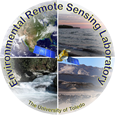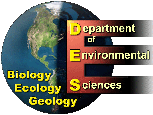EEES 4490/5490
Remote Sensing of the Environment
Course Overview: This course will acquaint
students with the fundamentals of the remote sensing process.
Students will become acquainted with a variety of airborne and
satellite sensor platforms which collect data in the visible, near
infrared, thermal and microwave portions of the electromagnetic
spectrum. By the end of the course the students should understand the
fundamental methods behind the different sensing techniques, and know
which techniques are best used to answer a wide variety of scientific
questions.
Students will be able to demonstrate their understanding of the
material through practical assignments and homework as well as exams.
This course will is offered at both the 4000 and 5000 level. Students
taking the course at the 4000 level will have approximately 6-8
computer based practical exercises and 2 exams. Students taking the
course at the 5000 level will be expected to complete all of the
requirements of the 4000 level course, plus the completion of either a
directed project or paper, with an in class presentation.
Text:
Course Topics:
Introduction to Remote Sensing
The remote sensing process
Electromagnetic Radiation Principles
Visible/near infrared radiation, Thermal infrared radiation, microwave
radiation
Elements of Photographic Systems
History; film characteristics; camera systems, Air Photo
Interpretation
Photogrammetry
Characteristics of vertical photos; determining scale; measuring
distances and heights of objects. Stereoscopic viewing-equipment;
image parallax; measurements using stereopair photographs.
Introduction to Electronic Sensors
Concept of spectral signatures; field radiometry; electronic scanning
systems.
Introduction to Optical Satellite Systems
Landsat/SPOT; Meteorological; Ocean, NASA, ESA, Private
Microwave Remote Sensing
Sensing process; interpretation of data; sensing systems- applications
SAR, Passive systemsn, Interferometry (optional)
Thermal Infrared Remote Sensing
Thermal signal sources and sensors; calibration issues; interpretation
of data; applications.
Remote Sensing of Vegetation
Spectral Vegetation Indices.
Aquatic Remote Sensing
Aquatic Optics
Remote Sensing identification of Lithology, Soils
Urban Remote Sensing
Land Use/Land Cover Classification
Digital Image Processing
Data Merging and scaling issues.


